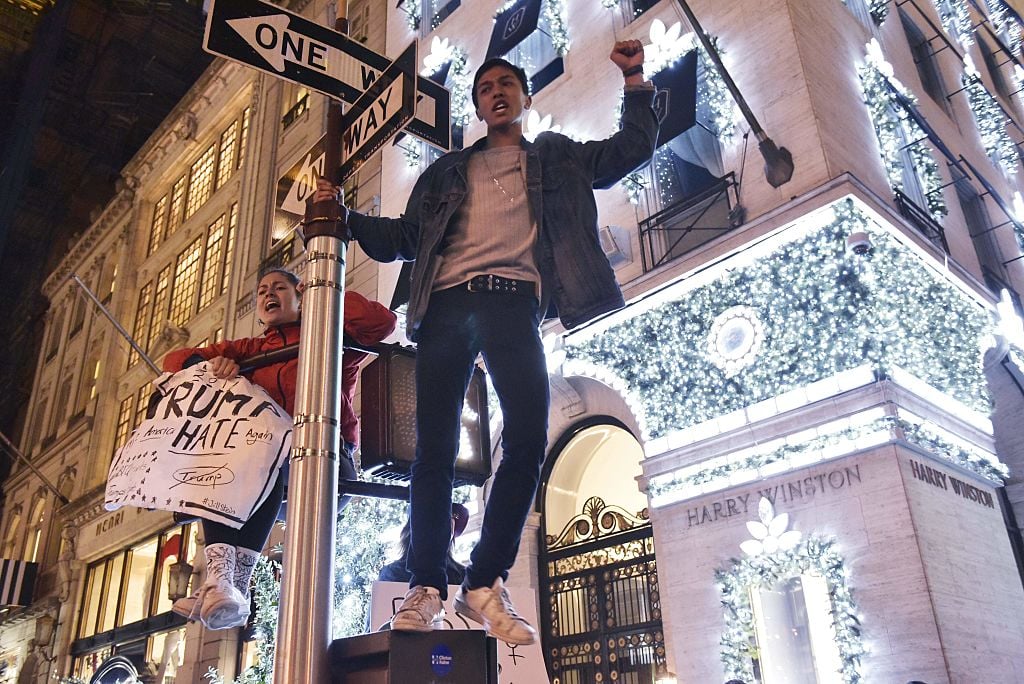
Secret Service agents, roadblocks, and protest marches are now a part of everyday life for art dealers in Midtown Manhattan. They may remain so indefinitely, since President-elect Donald Trump reportedly isn’t giving up his residency at Trump Tower on Fifth Avenue between 56th and 57th Street.
The impact on business and attendance has been dramatic, say dealers. Though the neighborhood has been superseded as a gallery capital by Chelsea, it is still host to galleries such as Marian Goodman, Mary Boone, and Pace Gallery, all within just a few moments’ walk from what is likely to remain Trump’s part-time residence.
New York City officials have asked the federal government to reimburse the city for some $35 million in estimated security costs between the election and the inauguration; art dealers have no such recourse for lost business.
“It’s crazy, and I think it’s only going to get worse,” said Brian Washburn, of Washburn Gallery.
“Attendance is down,” says Tibor de Nagy Gallery co-owner Eric Brown. “We are receiving regular calls and emails asking if we are open for business. We have had reporters and others coming up to use the facilities. The protesters, press, and crowds are certainly an impediment for clients, particularly older clients, of which we have many.”
While security concerns in the neighborhood were elevated during the campaign, says Ted Holland, artist liaison at Hirschl & Adler Modern, the situation worsened dramatically on November 9.
“Immediately, the morning after the election, there were sand-filled dump trucks lining the whole block of Trump Tower,” he told artnet News. “You couldn’t set foot on that block.”
The new reality affects not only attendance, but also shipping and other logistical aspects of gallery operations, Holland went on, saying that the police soon closed 56th Street.
Demonstrators rally near Trump Tower after marching through downtown protesting President-Elect Donald Trump on November 19, 2016 in Chicago, Illinois. Photo Scott Olson/Getty Images.
“And guess what? That’s where our loading docks are, so we couldn’t get any art in or out for at least a week,” he said. “The second week after the election, they started relaxing the rules, but we have to alert the Secret Service of any deliveries before they can be let onto 56th Street. If we have advance notice of a shipment, it’s fine, but we might have a runner who’s bringing something in. So they have to find parking and then walk the artwork down the street.
“We had to roll millions of dollars’ worth of art over to Sixth Avenue and then up to 57th Street, for loading into a truck, increasing the likelihood of damage,” said Holland.
Washburn points out that many other luxury retail operations, like Gucci, Harry Winston, Bulgari, and Tiffany & Co. are similarly sited. While commercial shipments have eventually been able to get through, he says, traffic to get to the area has been “horrendous.”
“It appears the situation won’t dissipate anytime soon,” says Eric Brown. “We will have the President of the United States living across the street from us!”
Normalcy may never return for these dealers even after a Trump presidency, either, since the Secret Service continues to provide security for ex-presidents for life. Other former presidents have retired to more remote locations, like George H.W. Bush’s home in Maine, or George W. Bush’s ranch near Crawford, Texas. The densely populated Midtown neighborhood presents an entirely different prospect.
Some clients simply don’t want to come to the area anymore, said Holland. “It was hard enough to get people to Midtown, and now they’re going to add what feels like the Ninth Circle of Hell,” he said, adding that “it’s hard enough to sell a piece of art in this economy since so many people are taking a ‘wait and see’ approach.
“It’s demoralizing, but we are working around it.”